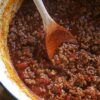4 Simple and Sustainable Tips to Reduce Food Waste at Home
Did you know that on average, we as Americans waste over 200 pounds of food per person each year? Imagine filling up your grocery cart to the brim with delicious food, paying the cashier, then leaving the store and throwing some of those bags into a dumpster on the way to your car. Not only would that be a waste of money, but also a waste of the time you spent selecting food, the nutrients that could have been used to nourish your body, and the resources that went into producing the food.
While this example may seem a bit unreasonable, it provides a mental picture of the resources we lose when food waste occurs. In industrialized countries, such as the U.S., more than 40% of food losses happen at the retail and consumer level – that means you can make an impact!
Experts and consumers alike are increasingly interested in eating a diet that is good for both our bodies and the environment. Although it is often suggested, we cannot simply eat or cut out a single food in order to solve this dilemma. Rather, the quest for a healthy, sustainable diet may lie in enjoying balanced meals including plant and animal products, choosing nutrient-dense foods over empty calories, and reducing the amount of food that is wasted.
Curious about beef sustainability? These animated infographics provide a snapshot of the relationship cattle have with the environment.
Check out the tips below to find out how you can reduce food waste and enjoy nutritious, satisfying meals.
Shop Smart
- Create a grocery list based on what meals you will make for the week – and stick to it!
- TIP: Online grocery shopping can be a useful tool to stay on track with your list.
- Buy in bulk if you will be able to use (or freeze) the food before it spoils.
- TIP: If you purchase a large value pack of steaks, take it home and place 1-4 steaks into freezer-safe bags to pull out for future meals.
- Before putting each item in your cart, think about how and when you will use it.
- Consider what shopping habits might help you prevent food loss.
- TIP: If you rarely have time to chop vegetables or fruit, paying a little more for the pre-chopped items may be an easy way to decrease waste (saving money in the long run).
Use it Up!
- “Shop” your refrigerator and pantry before going to the grocery store. Think about how you can use what you have and what you will buy to pair with.
- TIP: Leftover beef makes a great addition to breakfast, providing satisfying protein. Check out these beefy breakfast recipes and use cooked steak, roast or ground beef from a previous meal.
- Store leftover food items in clear containers in the refrigerator so you can easily see what you have.
- Pick a day or meal to eat leftovers (for example, Thursday night or Saturday lunch) and make it a routine.
- Use this Beef Loving Texans recipe generator to find recipes based on the ingredients you have at home.
Be Spoilage Savvy
- Dates on packages (including “Best if Used By”, “Sell-By”, and “Use-By”) do not reflect the day on which the food will be unsafe to consume. They simply indicate when the product should be eaten for the highest quality.
- TIP: Use the First In, First Out method in your fridge and pantry. Place recently purchased food behind what was already there, making it easier to eat food before it spoils.
- Pick up perishable foods, such as beef, just before checking out at the grocery store to keep them cold and fresh to prevent premature spoilage
- The color of red meat is not a reliable indicator of freshness or quality because it is influenced by factors including the animal it came from and exposure to light and oxygen. Instead, check to see if there is an off odor or if the meat is slimy or sticky to the touch.
Go on a Food Rescue Mission
- If you will not be able to eat food in your fridge before it spoils, freeze it for future use. For easy meals later, package food in single meal servings (individual or family). For a guide about refrigerator and freezer storage times, check out this chart.
- Get creative with recipes. For example, if you have zucchini, carrots, or similar vegetables that need to be used up , grate them and throw them in these Lone Star Beef and Veggies Burgers.
- Smoothies are a great way to use up produce that is becoming a little soft or is bruised. For an added bonus, freeze individual servings of the smoothie for future enjoyment.
Although beef is one of the least wasted foods in the U.S., you can take these steps to ensure that the tasty and protein-packed product, as well as other foods, are used to fuel our bodies rather than ending up in a trash bin. Limiting food waste can help maximize resources including environmental inputs, nutritious foods, and money in your bank account. That’s a win win.
Did you know? Reducing Food Waste doesn’t mean sacrificing flavor. Try these versatile recipes with ingredients you have.
Substitute the vegetables for the produce you have in your fridge! Broccoli, Brussel sprouts or even apples would be tasty.
Get creative with what you include in this wrap.
- Already have a grain (rice, quinoa, couscous), veggies, and cooked beef in the refrigerator? Then, you have all you need for a power bowl made to your liking. Have lettuce or spinach, too? Make a green salad!
- Burger on a Salad Four Ways
- Try the Greek, American, Mexican or Asian variation, or create your own unique combination.













